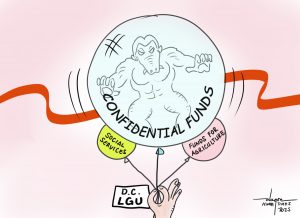 FOR ALL the hardships and inconveniences that are made to bear on the road users of the barangay road from Talandang in Tugbok District to Calinan Proper and from Calinan Proper stretch of the Bukidnon-Davao national highway up to Tamugan at this time that the Apo Agua Infrastructura, Inc. is digging a huge canal for its water pipes, a serious evaluation of the things the company is doing will show that still the benefits far outweigh its temporary negative impact on the community affected.
FOR ALL the hardships and inconveniences that are made to bear on the road users of the barangay road from Talandang in Tugbok District to Calinan Proper and from Calinan Proper stretch of the Bukidnon-Davao national highway up to Tamugan at this time that the Apo Agua Infrastructura, Inc. is digging a huge canal for its water pipes, a serious evaluation of the things the company is doing will show that still the benefits far outweigh its temporary negative impact on the community affected.
Yes, for over a year now these roads have become the so-called road of perdition because in most of the stretch from Talandang to Calinan only one lane can be used by motorists.
In fact, of late at certain portions, the motorists have to be re-routed to a much more circuitous way before reaching Calinan Proper. On the main highway to Bukidnon, roughly five meters of the roadside cannot be used by motorists because the diggings are now done in the area.
Woe to the establishments located on that side as their employees and customers have to suffer the inconveniences and the risks upon entering or getting out of the premises of any establishment and endure the dusts during sunny days, and the mud or accumulated water when rains prevail.
Based on the time-table for the completion of the Apo Agua’s Bulk Water Supply Project for Davao City Water District (DCWD) the inconveniences will last until 2022 or a year from now. And it is not even certain yet given the delays brought about by the raging CoViD 19 pandemic and the ever changing weather situation in this part of the country.
Now talking of benefits the project when completed, will assure a steady supply of potable water in a huge area of Davao City, especially in its northern part. The area, as many Davaoenos are well aware of, had long been suffering from poor quality water supply. More so now that development of the city is fast moving to the northern sector.
But of course this is the long-term benefit desired in the implementation of the Bulk Water Supply Project. There are short but immediate term benefits that out-shine the hardships being suffered by motorists and commuters alike.
The on-going digging and pipe-laying activities conducted by the contractor of the project have benefited a huge number of people. First the suppliers of raw materials and other project requirements
Then there are also the service providers such as those that are renting out heavy equipment, dump trucks hauling the huge pipes as well as the extracted soil and other debris, and those supplying the construction materials for the processing plant of the surface water in Tamugan and the small dam facility that is expected to also run a mini hydro-electric plant.
Above all, the Apo Agua Project has become the savior of hundreds of banana plantation workers in a multi-nationally owned farm that closed in April of last year due to alleged disagreement between the executives of the plantation and the landowners’ cooperative that was leasing the agrarian reform distributed area.
But whatever was the real reason behind the stoppage of the banana farm operation we could not care much. What we are thankful about is the accommodation by the main contractor of the Apo Agua project of many of the displaced male farm workers.
They are now part of the hand or mechanized digging brigade of the JV Angeles Construction. In addition a huge number of tricycle drivers whose income had been negatively affected by the restriction in people’s movement are also hired by the company in its effort to meet the project completion deadline.
In other words, at this time when hundreds of families in Calinan and its nearby barangays could have been suffering from destitution because of loss of income, they are embraced by one company through its multi-billion pesos project. They have food on their table because they are earning money amidst the deprivation under the pandemic regime.
So, what then are the hardships and inconveniences compared to the lives of many families given the opportunity to live life in the most trying times?
****************************
Last Saturday night most part of Davao City’s downtown areas were submerged in water again. And the strong rains poured only in about a little over an hour.
What more if the rains lasted for two or three hours? Perhaps the Matina Pangi or the Davao River will overflow and make the city a true version of Water World?
What happened to the ever-extended implementation of the city’s drainage project? Yes, we saw many areas in the city’s downtown excavated to give way for the laying of large drain pipes and construction of box culverts. But based on last Saturday night’s flooding and other previous experiences of the city being submerged in flood waters, somehow one can easily be convinced that the drainage project has not alleviated the condition.
What and where exactly is the problem emanating? Is it in the city’s downtown area, or is it the uptown where most of the time the sources of flood water come when it rains heavily?
We believe that there is failure by our city engineering planners to pinpoint exactly where and what the problem is. The urban area’s drainage system may only be one reason for the flooding. But why do our rivers overflow so fast and why are its waters now taking shortcut routes other than the main waterways?
It is our take that last Saturday’s sudden flooding signals the need to revisit development plans that the city has made for implementation and that whatever projects lined up there especially with regards to flood control must be complementary with each other.
The local, as well as national projects, must not be done on a “To each his own” scheme. And the projects – government or privately initiated — should be scrutinized to the teeth especially on the aspects of their intervention of nature’s way.


